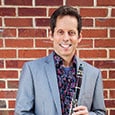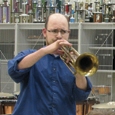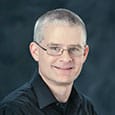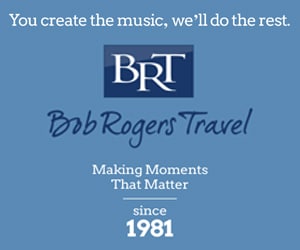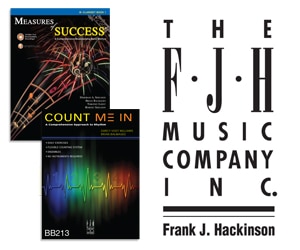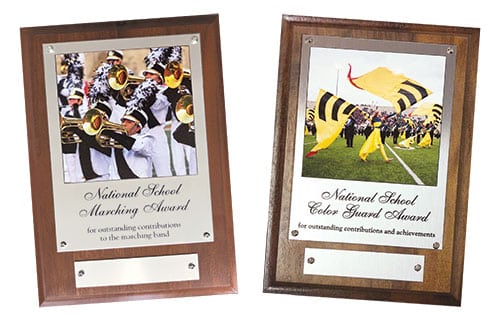Rehearsing with the Triangle Youth Jazz Ensemble
Gregg Gelb has directed the Triangle Youth Jazz Ensemble for the past 13 years. The ensemble is part of the Triangle Youth Music Program based in Raleigh, North Carolina. The organization serves over 500 students year-round and offers multi-level programming including three orchestras, four jazz bands, two string orchestras, several small ensembles, and an after-school beginner violin program. Students audition annually to play in this regional group, which meets once a week on Sundays for three hours. Gelb and the advanced band were invited to the 2024 Midwest Clinic.
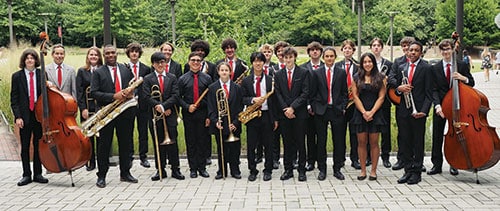
How has the jazz program developed during your time there?
In the Triangle, there are several local universities including UNC-Chapel Hill, North Carolina Central University in Durham, and North Carolina State in Raleigh. These schools present great jazz artists plus there have always been many fine local players. All of this helps create a big interest in jazz in the area. The Essentially Ellington program in New York has been the biggest motivator for improving the program. I learned of it just as I started directing and was interested in the free teaching materials. Our band auditioned three times without making it and then earned invitations eight years in a row.
The chance to travel and play at Essentially Ellington has been a driving force for the organization and has increased the number of players who auditioned for our band. When you start aiming for perfection, students know it and want to take that trip. This year we are going to Midwest. I don’t know that much about Midwest, but I know that it is really top notch, so the players are very excited about the performance.
With Essentially Ellington, the music is such a great teaching tool even though it predates the students and their parents. What makes that music such powerful motivation?
The music is of the highest quality, and it is amazing every year that high school students can make it sound good with enough practice. We bring in other teachers for clinics and spend considerable time discussing and listening to the music. Our rehearsals are dedicated to matching the original feeling and style as closely as we can. The music is an art form just like classical music. Everything you need to know is on the page and the recordings. The key is putting in the rehearsal time needed to get it right. When you go to Essentially Ellington, all fifteen bands in the finals are fairly close in ability.
How have you approached the music for your Midwest concert?
With the Midwest Clinic, you have to perform music at various grade levels. I have found that the band had to rehearse the easy music just as much as the harder music. I haven’t done anything differently for Midwest than for Essentially Ellington except that we have eight charts to play instead of three. It is liberating to prepare new and unfamiliar music from a range of composers and publishers. There is also no competitive pressure with Midwest. You just do your best.

How did you select music for your Midwest performance?
Music selection for Midwest was challenging for several reasons. For the last dozen years, I have relied on tunes from the Essentially Ellington library. Every year Jazz at Lincoln Center sends out about eight new transcriptions free to bands around the country. For bands applying for competition, at least one of those new charts has to be recorded for the audition. If the band makes it to the finals, then all three pieces performed have to be from the EE library, including at least one from the current year’s catalog.
This process has kept it fairly easy for me to select tunes. Of course, I had to figure which fit my band the best, which feature the soloists I want featured, and which have a dynamic show quality to them.
Preparing for the Midwest Clinic was completely different from our other prestigious performances. I had to select 45 minutes worth of music or about eight tunes. The basic rules for selection are that half of these pieces have to be grades 1-3 and the other half grades 4-6. Also, most of the works have to be recently published and represent many different publishers. There are also rules for diversity in the composers represented on the concert.
I am not the typical jazz band director. My group meets for 3 hours on Sundays, and I am most familiar with the EE repertoire. I’m an independent educator, performer, composer/arranger, and don’t teach at a school full time.
It took intensive research to pick music for this performance. I listened to a bunch of Grade 1-6 big band music and tried to listen to everything offered by about a dozen publishers.
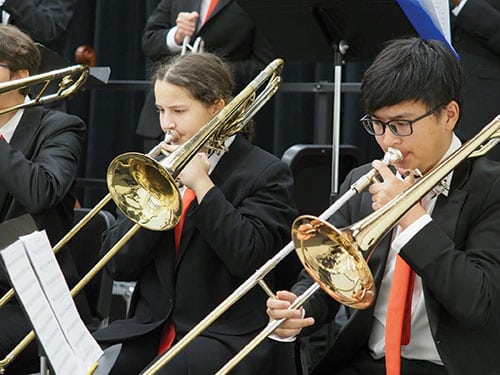
By June, my list narrowed to about sixty arrangements, and I kept weeding out tunes over the summer. As I narrowed the list, I considered how the pieces contrasted in tempo, style, and rhythm to develop a varied and interesting program. I also figured which tunes would be good for our soloists, which was difficult because auditions for the band were held at the end of August. When the band finally met for its first rehearsal around Labor Day, I knew which students should be featured. I try to give equal solo space to our many fine soloists and finally decided on the final program in early September.
What are some of your favorite tunes on the program?
I like all of the tunes because each has a special character and purpose. I am impressed with the writing of all the composers: Kris Berg’s Bartók Takes The Trane, Mike Tomaro’s Art-istry, and Michele Fernández’s arrangement of My Favorite Things are our most challenging charts to play and have the brightest tempos. They are really fantastic pieces.
Surprisingly, the grade 1 and 2 pieces have been just as challenging because it’s hard to play slower tempos. The students need to bring some big feeling and expressive skills to make these pieces come to life.
The chance to work with guest artists has also been a great part of the Midwest experience. Our guest soloists haven’t rehearsed with us yet, but I think they will fit in perfectly. Summer Camargo and Pablo Muller will play on Art-istry and My Favorite Things. Rodney Whitaker and Colleen Clark will play on Colleen’s combo tune Car-o-lina and Todd Stoll will perform Such Sweet Thunder. I’m looking forward to this performance and think the audience will have a great time listening to the selections and our group.
How do you develop a cohesive sound with your group, given the limited rehearsal time?
I can’t take all the credit. Lisa Burn and Kobie Watkins also direct bands in the program, and their work contributes greatly to our success and cohesion. Because the students go to various schools, we encourage them to hold sectionals and play together outside of rehearsal, but it usually ends up happening before or after rehearsals on Sundays. We try to get as many coaches as we can. Ron Carter moved to this area after retiring from Northern Illinois University and worked with us at least once a year. He was such a great motivator. His entire philosophy has worn off on us and influenced how we teach.
How do you make the most of rehearsals?
It is a regional group, so I can work hard with these kids because they want to be there. They understand why we go over and over the music to get it right. I know the arrangements and the recordings well, and know what my students are supposed to sound like. I am still learning, but every time I look at a score, I get excited and want to produce an authentic performance using the music and the recordings as a guide.
It all goes back to Ron Carter. He emphasized that if the music isn’t swinging, it isn’t going to be right. It starts with getting the bass and rhythm section swinging. We talk about the importance of following the lead players on intonation and articulations. If I hear something that isn’t right, I stop right away and sing to them. Then, I get them to sing the correct articulations.
What are you looking forward to besides the performance?
Because we only meet on Sundays, we don’t really know each other that well. I’m looking forward to seeing what going somewhere together will do for our group. I know they will be inspired by watching the other jazz bands there. It is going to be amazing.
* * *
In addition to his work with the Triangle Youth Jazz Ensemble, Gregg Gelb is a saxophonist and clarinetist and leads several groups: his Jazz Quartet, La Fiesta Latin Jazz Band, Second Line Stompers, and Swing Band. He is founder and director of the Heart of Carolina Jazz Orchestra and Jazz Society and co-founder and player with the North Carolina Jazz Repertory Orchestra. His groups have recorded over a dozen CDs. He has a Bachelor of Music Education degree from Berklee College of Music, a Master of Music degree from the UNC School of the Arts, and a DMA from UNC Greensboro.
